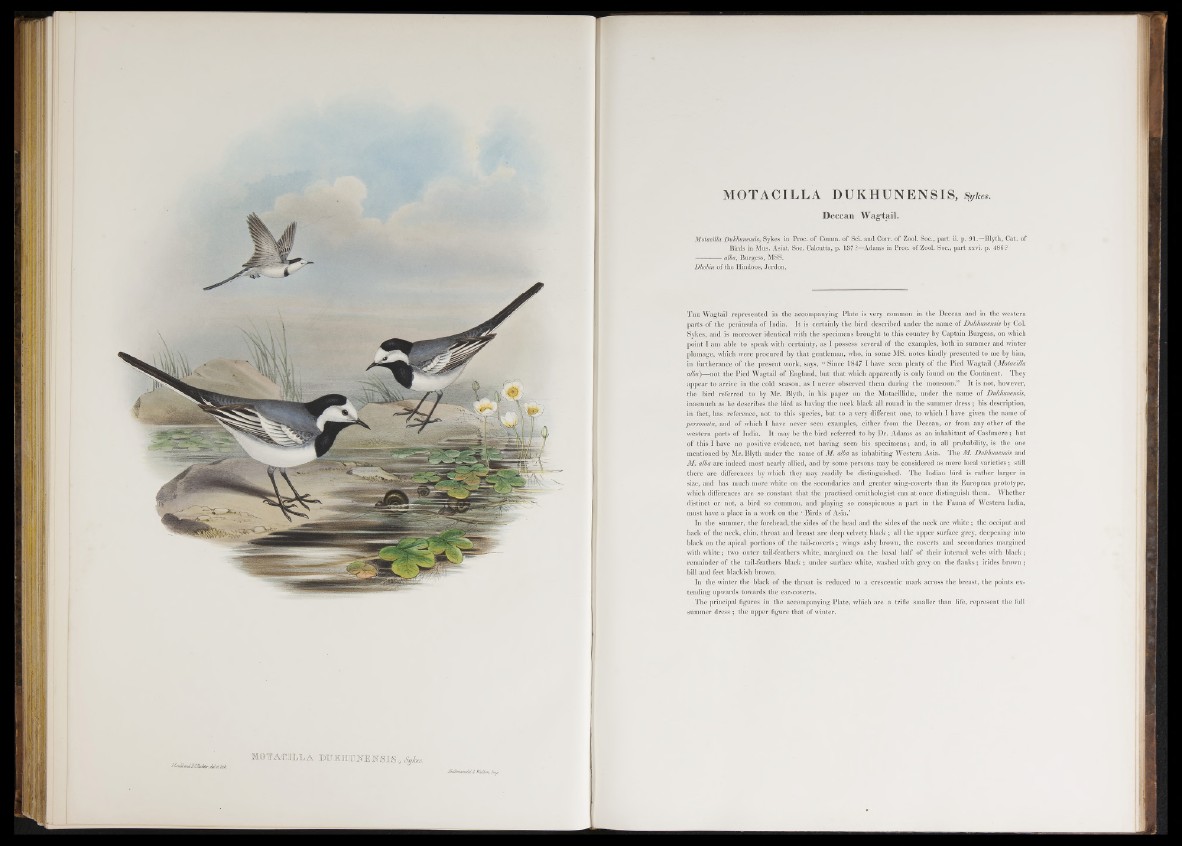
J-GmtManlECJicc/io-, dtld&ih
MOTACILLA BUKMITKjEliSIS, Sykes.
MOTACILLA DUKHUNENSIS , fyke*.
Deccan Wag*tail.
Motacilla Dukhunensis, Sykes in Proc. of Comm, of Sci. and Corr. of Zool. Soc., part ii. p. 91.—Blyth, Cat. of
Birds in Mus. Asiat. Soc. Calcutta, p. 137 ?—Adams in Proc. of Zool. Soc., part xxvi. p. 486 ?
------------alba, Burgess, MSS.
Dhobin of the Hindoos, Jerdon.
T h e Wagtail represented in the accompanying Plate is very common in the Deccan and in the western
parts of the peninsula of India. I t is certainly the bird described under the name of Dukhunensis by Col.
Sykes, and is moreover identical with the specimens brought to this country by Captain Burgess, on which
point I am able to speak with certainty, as I possess several of the examples, both in summer and winter
plumage, which were procured by that gentleman, who, in some MS. notes kindly presented to me by him,
in furtherance of the present work, says, “ Since 1847 I have seen plenty o f the Pied Wagtail (Motacilla
alba)—not the Pied Wagtail of England, but that which apparently is only found on the Continent. They
appear to arrive in the cold season, as I never observed them during the monsoon.” It is not, however,
the bird referred to by Mr. Blyth, in his paper on the Motacillidse, under the name of Dukhunensis,
inasmuch as he describes the bird as having the neck black all round in the summer d res s ; his description,
in fact, has reference, not to this species, but to a very different one» to which I have given the name of
personata, and o f which I have never seen examples, either from the Deccan, or from any other of the
western parts of India. I t may be the bird referred to by Dr. Adams as an inhabitant of Cashmere ; but
of this I have no positive evidence, not having seen his specimens; and, in all probability, is the one
mentioned by Mr. Blyth under the name of M. alba as inhabiting Western Asia. The M. Dukhunensis and
M , alba are indeed most nearly allied, and by some persons may be considered as mere local varietieis; still
there are differences by which they may readily be distinguished. The Indian bird is rather larger in
size, and has much more white on the secondaries and greater wing-coverts than its European prototype,
which differences are so constant that the practised ornithologist can at once distinguish them. Whether
distinct or not, a bird so common, and playing so conspicuous a part in the Fauna of Western India,
must have a place in a work on the ‘ Birds of Asia.’
In the summer, the forehead, the sides of the head and the sides of the neck are wh ite; the occiput and
back of the neck, chin, throat and breast are deep velvety black ; all the upper surface grey, deepening into
black on the apical portions of the tail-coverts; wings ashy brown, the coverts and secondaries margined
with white; two outer tail-feathers white, margined on the basal half of their internal webs with black;
remainder of the tail-feathers black ; under surface white, washed with grey on the flanks; irides brown ;
bill and feet blackish brown.
In the winter the black of the throat is reduced to a crescentic mark across the breast, the points extending
upwards towards the ear-coverts.
The principal figures in the accompanying Plate, which are a trifle smaller than life, represent the full
summer dress ; the upper figure that o f winter.